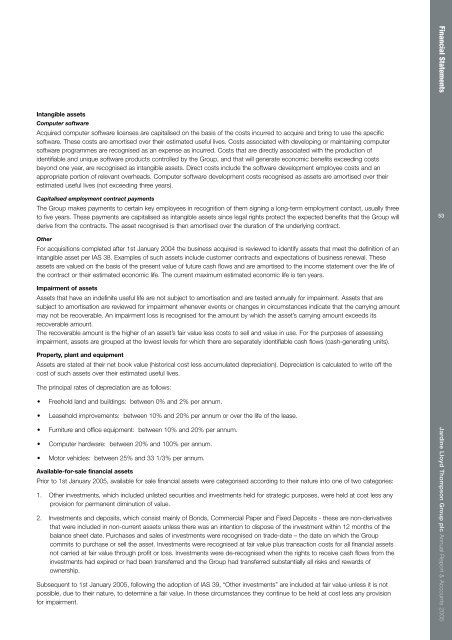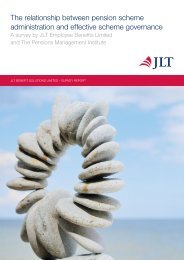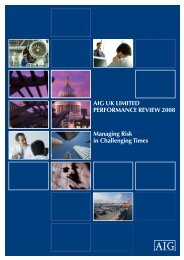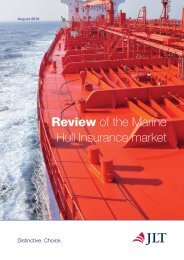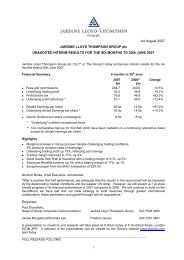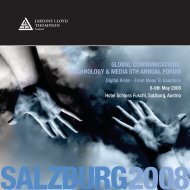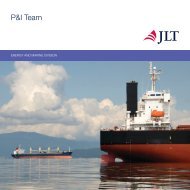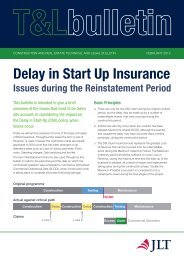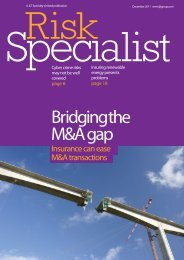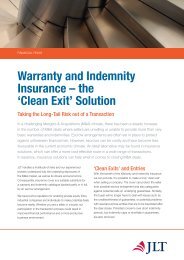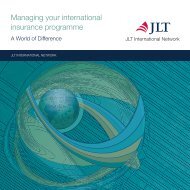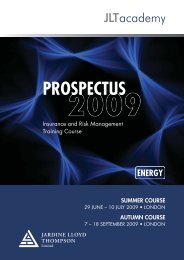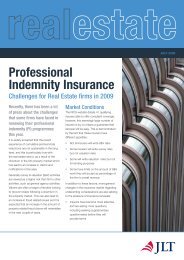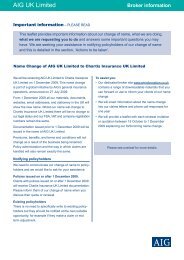Report & Accounts - JLT
Report & Accounts - JLT
Report & Accounts - JLT
- No tags were found...
You also want an ePaper? Increase the reach of your titles
YUMPU automatically turns print PDFs into web optimized ePapers that Google loves.
Intangible assetsComputer softwareAcquired computer software licenses are capitalised on the basis of the costs incurred to acquire and bring to use the specificsoftware. These costs are amortised over their estimated useful lives. Costs associated with developing or maintaining computersoftware programmes are recognised as an expense as incurred. Costs that are directly associated with the production ofidentifiable and unique software products controlled by the Group, and that will generate economic benefits exceeding costsbeyond one year, are recognised as intangible assets. Direct costs include the software development employee costs and anappropriate portion of relevant overheads. Computer software development costs recognised as assets are amortised over theirestimated useful lives (not exceeding three years).Capitalised employment contract paymentsThe Group makes payments to certain key employees in recognition of them signing a long-term employment contact, usually threeto five years. These payments are capitalised as intangible assets since legal rights protect the expected benefits that the Group willderive from the contracts. The asset recognised is then amortised over the duration of the underlying contract.OtherFor acquisitions completed after 1st January 2004 the business acquired is reviewed to identify assets that meet the definition of anintangible asset per IAS 38. Examples of such assets include customer contracts and expectations of business renewal. Theseassets are valued on the basis of the present value of future cash flows and are amortised to the income statement over the life ofthe contract or their estimated economic life. The current maximum estimated economic life is ten years.Impairment of assetsAssets that have an indefinite useful life are not subject to amortisation and are tested annually for impairment. Assets that aresubject to amortisation are reviewed for impairment whenever events or changes in circumstances indicate that the carrying amountmay not be recoverable. An impairment loss is recognised for the amount by which the asset’s carrying amount exceeds itsrecoverable amount.The recoverable amount is the higher of an asset’s fair value less costs to sell and value in use. For the purposes of assessingimpairment, assets are grouped at the lowest levels for which there are separately identifiable cash flows (cash-generating units).Property, plant and equipmentAssets are stated at their net book value (historical cost less accumulated depreciation). Depreciation is calculated to write off thecost of such assets over their estimated useful lives.The principal rates of depreciation are as follows:• Freehold land and buildings: between 0% and 2% per annum.• Leasehold improvements: between 10% and 20% per annum or over the life of the lease.• Furniture and office equipment: between 10% and 20% per annum.• Computer hardware: between 20% and 100% per annum.• Motor vehicles: between 25% and 33 1/3% per annum.Available-for-sale financial assetsPrior to 1st January 2005, available for sale financial assets were categorised according to their nature into one of two categories:1. Other investments, which included unlisted securities and investments held for strategic purposes, were held at cost less anyprovision for permanent diminution of value.2. Investments and deposits, which consist mainly of Bonds, Commercial Paper and Fixed Deposits - these are non-derivativesthat were included in non-current assets unless there was an intention to dispose of the investment within 12 months of thebalance sheet date. Purchases and sales of investments were recognised on trade-date – the date on which the Groupcommits to purchase or sell the asset. Investments were recognised at fair value plus transaction costs for all financial assetsnot carried at fair value through profit or loss. Investments were de-recognised when the rights to receive cash flows from theinvestments had expired or had been transferred and the Group had transferred substantially all risks and rewards ofownership.Subsequent to 1st January 2005, following the adoption of IAS 39, “Other investments” are included at fair value unless it is notpossible, due to their nature, to determine a fair value. In these circumstances they continue to be held at cost less any provisionfor impairment.Financial Statements Jardine Lloyd Thompson Group plc Annual <strong>Report</strong> & <strong>Accounts</strong> 200553


